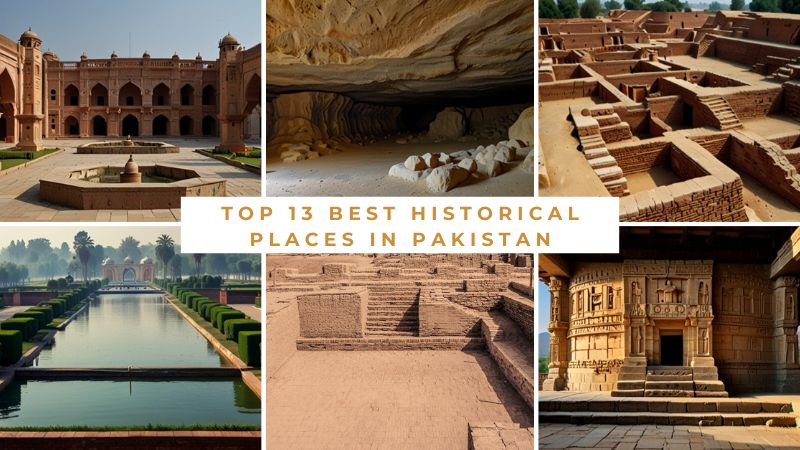Introduction:
Pakistan has a long history of ancient civilizations, medieval dynasties, and many historical monuments that serve as the gateway to its rich heritage. From the mysterious ruins of the Indus Valley Civilization to the majestic Mughal architecture, each historical site tells a story of renewal, innovation and leadership. In this quest, we will take a detailed journey through Pakistan’s top 10 historical places, delving into their significance, architectural perspective and other exciting details.
Top 13 Best Historical Places in Pakistan
Best 13 Historical Places in Pakistan Here:
- Mohenjo-Daro
- Taxila
- Lahore Fort and Badshahi Mosque
- Shalimar Gardens
- Rohtas Fort
- Hiran Minar
- Takht-i-Bahi
- Derawar Fort
- Makli Necropolis
- Katas Raj Temples
- Harappa
- Lahore Museum
- Hiran Cave Complex
Mohenjo-Daro:
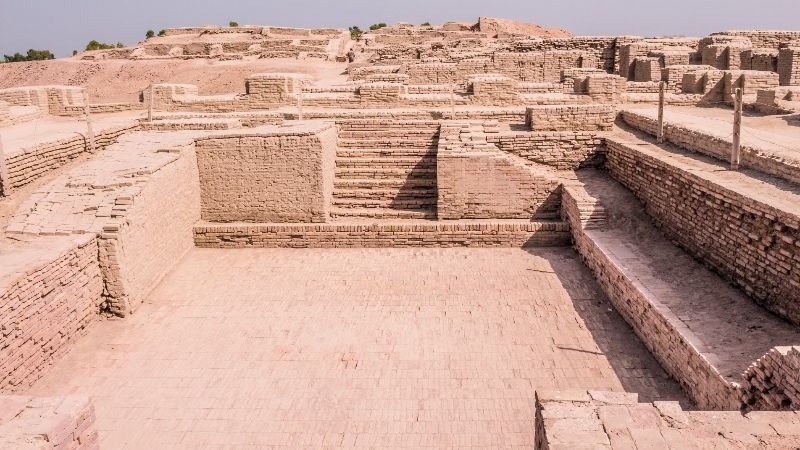
Mohenjo-Daro was excavated in the 1920s BC. It is one of the oldest urban settlements in the world, dating back to 2500 BC. It has a high level of success and urban planning with a simplified process and efficient plans. The discovery of artefacts such as seals, pottery, and water wells points to a thriving society with significant trade and culture.
Taxila:
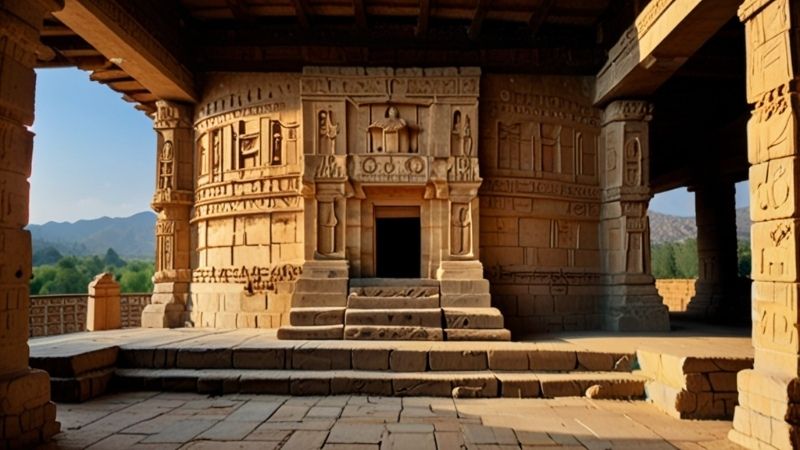
Taxila is an ancient city in modern-day Punjab. It was an essential educational and trade centre during the Gandhara civilization [Best Historical Places in Pakistan]. It is the meeting point of cultures inspired by Greek, Persian and Indian civilizations. Dharmarajika Stupa, Sirkap City ruins and Jaulian Buddhist Monastery are famous archaeological sites that display a fusion of artistic styles.
Also Read: Best Places to Visit in Karachi With Family
Lahore Fort and Badshahi Mosque:
Lahore Fort was built during the Mughal period and is a testament to the architecture of the Ottoman Empire. The fort complex includes impressive buildings such as Shish Mahal (Mirror Palace), Moti Masjid, and Alamgiri Gate. Next to the fort is the Badshahi Mosque, a masterpiece of Mughal architecture decorated with intricate marble work and calligraphy and boasting one of the most giant domes in the world.
Shalimar Gardens:
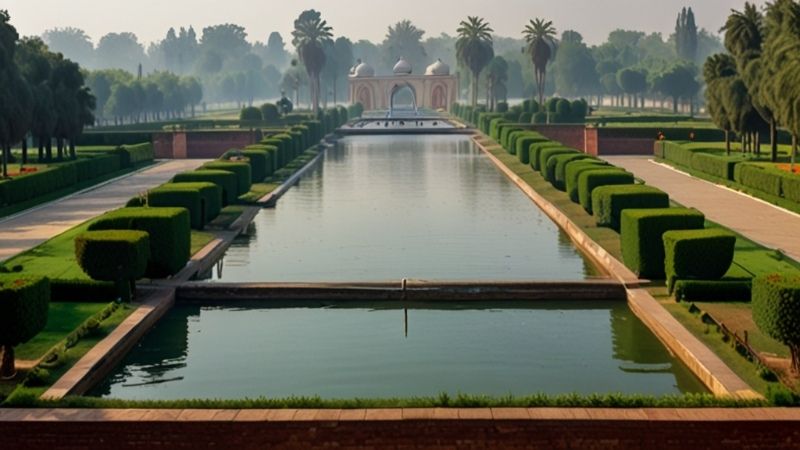
Shalimar Gardens, built by Lahore Emperor Shah Jahan in the 17th century, epitomizes Mughal garden architecture. The garden features three terraces filled with cascading fountains, pavilions and lush greenery, symbolizing the Islamic concept of heaven on earth. The complex water system called “Shah Nahar” represents the engineering marvel of the age.
Rohtas Fort:
Built by Sher Shah Suri in the 16th century, Rohtas Fort was a stronghold against Mughal Emperor Humayun [Best Historical Places in Pakistan]. Its great wall stretches for 4 kilometres and is fortified with 68 bastions and 12 gates, demonstrating the military prowess of its builders. The fort’s architecture blends Afghan, Hindu, and Mughal styles, making it a unique place.
Hiran Minar:
Hiran Minar is located in Sheikhupura and is a testament to Emperor Jahangir’s love for nature and animals. The minaret is 30 meters high and was built in memory of his beloved deer, Mansraj. The facade of the minaret is decorated with geometric patterns, Persian inscriptions and stone carvings and offers magnificent views of the surrounding landscape.
Takht-i-Bahi:
Takht-i-Bahi, perched atop a hill near Mardan, is a World Heritage Site designated by UNESCO that displays the architectural skills of ancient Gandhara workers. This building, dating back to the 1st century AD, was a church and an educational centre. The school has a main prayer hall decorated with stupas, monasteries, and beautiful statues depicting religious themes.
Derawar Fort:
Derawar Fort is a massive 9th-century settlement in the Cholistan desert. It is believed to have been built by Hindu Rajput rulers and later came under the control of many dynasties, including the Abbasid Empire and the Mughal Empire. The castle’s high walls and bastions offer expansive views of the surrounding desert terrain, making it a well-liked tourist destination.
Makli Necropolis:
Makli Necropolis near Thatta is one of the largest cemeteries in the world, covering 10 square kilometres. More than half a million tombs, mausoleums, and monuments depict the different architectural styles of medieval Sindh. Intricately carved dolmens and funerary art combine Sindhi, Persian, and Mughal influences, making it a UNESCO World Heritage Site.
Katas Raj Temples:
Located on the salt range near Chakwal, Katas Raj Temple is a group of ancient Hindu temples dating back to 6 AD. Dedicated to Lord Shiva, these temples are known for their exquisite beauty, intricate carvings, and sacred lakes. The site has religious significance for Hindus and is a tourist destination attracting devotees worldwide.
Harappa:
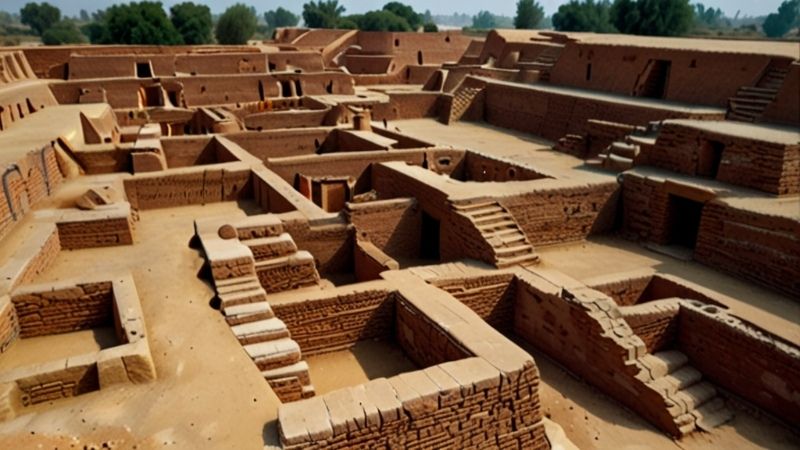
Harappa, studied with Mohenjo-Daro, is another important historical site for the Indus Valley Civilization. Harappa gives insight into urban life, business contacts, and technology in one of the world’s most advanced civilizations in the Punjab province. Excavations reveal well-planned buildings, houses, banks, and weak water pipes that show ancient life’s social and economic conditions.
Lahore Museum:
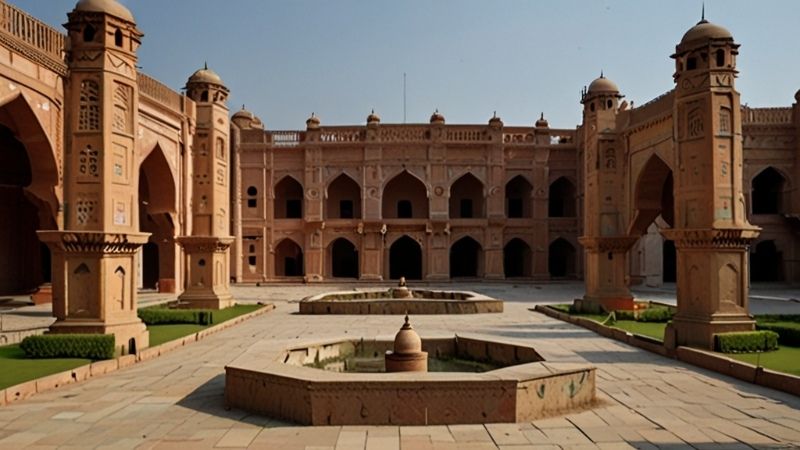
Established in 1894, Lahore, one of Pakistan’s oldest and most esteemed museums, is the Museum [Best Historical Places in Pakistan]. It exhibits many artefacts spanning centuries of history and cultural dominance. Located in Lahore, the Museum has a beautiful collection of Gandhara statues, Mughal miniature paintings, Islamic calligraphy, ancient coins and Indus Valley artefacts. It is a treasure trove for historians, archaeologists and art lovers, providing insight into Pakistan’s diverse ethnic mosaic.
Hiran Cave Complex:
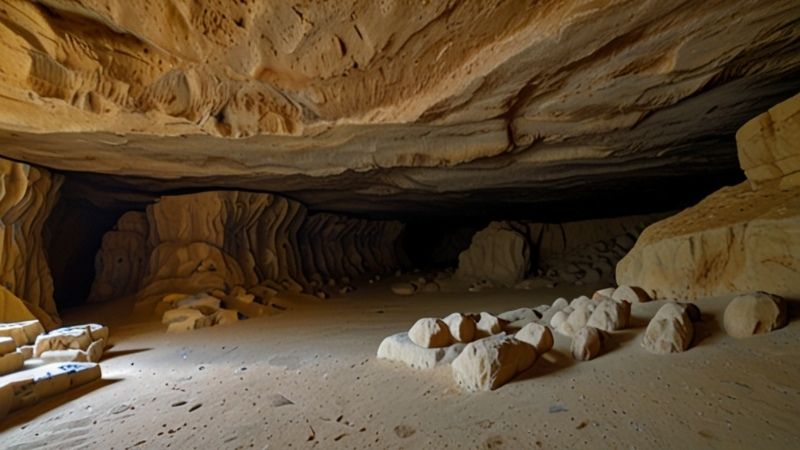
The Hiran Caves complex near Quetta in Balochistan is a well-known archaeological site that dates to the Paleolithic and Neolithic ages. Discovered in the 1970s, this cave contains evidence of early human habitation, including rock paintings, tools and artefacts. The site provides information about the lifestyles, hunting and rituals of prehistoric communities in the region, allowing us to understand the evolution of society and culture in South Asia.
Conclusion:
Pakistan’s historical monuments witness the country’s rich and diverse cultural heritage. From the ancient ruins of Mohenjo-Daro to the majestic Lahore Fort and serene Takht-i-Bahi, each place embodies centuries of history, art, and innovation [Best Historical Places in Pakistan]. As custodians of these treasures, we are responsible for preserving and supporting these precious tools for future generations, perpetuating their admirable and awe-inspiring existence for centuries.
Best Historical Places in Pakistan – FAQs:
Q1. What is the oldest place in Pakistan?
Ans. In Pakistan, Mohenjo-Daro is an ancient city where people lived long ago (around 2600 BC). It is like a time capsule from the Indus Valley Civilization, one of the most successful civilizations.
Q2. How many historical monuments are there in Pakistan?
Ans. Pakistan has six World Heritage Sites, with 26 more on the list. The first three sites added to the list in 1980 were Sahr-i-Bahlol, the archaeological site of Mohenjo-Doro, the Takht-i Bahi mosque, and the ruins of the neighbouring cities of Bahlol and Taxila.
Q3. What is the historic object in Pakistan?
Ans. Lahore Fort, sometimes referred to as Royal Fort or Shahi Qila, is situated within the walls of Lahore and is one of the city’s tourist attractions. The castle covers an area of 20 hectares, and the fort also has 21 monuments from the Akbar period.
Q4. What was the old name of Pakistan?
Ans. In the 1933 book Now or Never, Rahmat Ali and our Cambridge colleagues wrote for the first time the abbreviations for Punjab, Afghanistan (North West Frontier Province), Kashmir, and the Indian province of Sindh, with the stan suffix from Balochistan.

